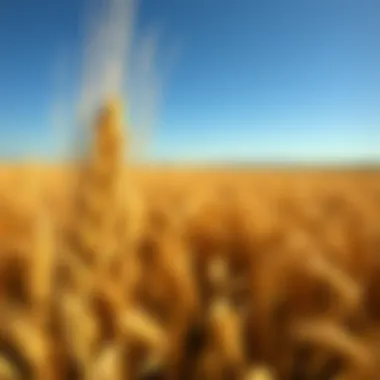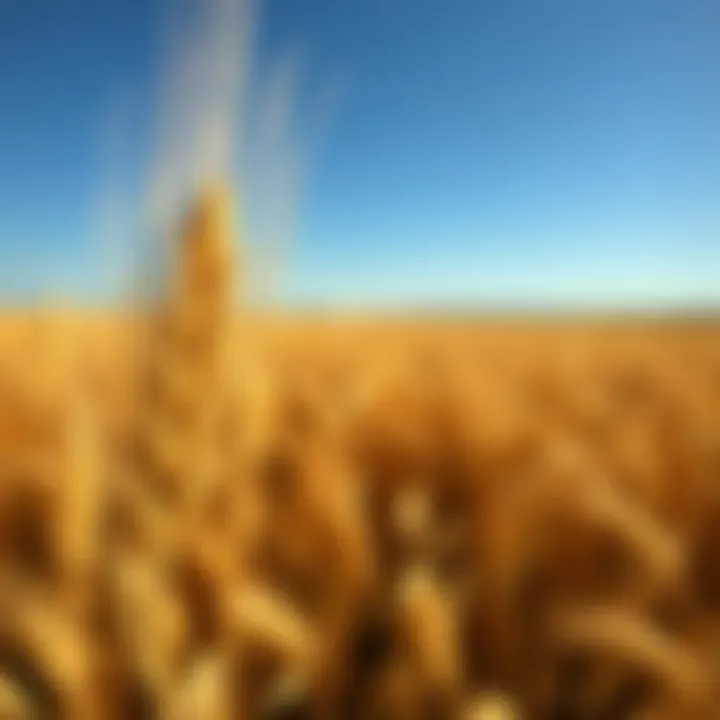Insights and Strategies for Agricultural Grain Markets


Topic Overview
Agricultural grain markets have long been the backbone of the global economy, weaving together the fabric of food security and trade. Understanding these marketplaces goes beyond just recognizing supply and demand; it's about grasping the intricate dynamics that govern prices, influence farmer decisions, and shape international policies. The grain market isn't static; it continually shifts like the winds on the open plains, influenced by a myriad of factors, including weather patterns, technological breakthroughs, and government regulations.
Definition and Importance
At its core, the agricultural grain market is a complex system that encompasses the buying and selling of crops like wheat, corn, barley, and rice. The significance of these commodities cannot be understated as they play a crucial role in not only feeding populations but also in providing livelihoods for millions of farmers worldwide. The grain market acts as a barometer for global agricultural health, reflecting broader economic indicators and environmental shifts.
Brief History and Evolution
The journey of agricultural grain markets has evolved dramatically over the centuries. From ancient barter systems to today’s digital exchanges, the mechanisms of trade have transitioned alongside societal needs and technologies. In the early days, grains were the currency of civilizations, often used to pay laborers or settle debts.
Fast forward to the twenty-first century, where technological progress has catalyzed a new era in these markets. With the advent of data analytics, satellite imagery, and blockchain, stakeholders now navigate the market landscape with a level of sophistication unseen in previous generations. Farmers can make informed decisions based on real-time data, ensuring greater efficiency and sustainability.
Key Techniques and Innovations
To thrive in these dynamic markets, both farmers and agronomists must embrace modern practices and tools. The following sections unveil critical advancements.
Sustainable Farming Practices
Sustainability is more than just a buzzword; it’s a necessity in today’s agricultural scene. Methods such as crop rotation, cover cropping, and integrated pest management are increasingly significant. These practices not only enhance soil health but also improve yield and reduce the need for chemical fertilizers and pesticides.
- Crop Rotation: Alternating crops helps break pest cycles and enhances soil nutrients.
- Cover Cropping: Planting cover crops during off-seasons maintains soil moisture and suppresses weeds.
- Integrated Pest Management: Combining biological control with traditional pest control minimizes chemical usage.
Advanced Agronomic Technologies
Technological innovations serve as powerful allies in navigating grain markets. Precision agriculture, utilizing GPS and IoT sensors, has revolutionized how farmers engage with their fields.
- Drones: Provide aerial imagery to assess crop health and growth.
- Soil Sensors: Gauge moisture levels and nutrient content, facilitating timely interventions.
- Big Data Analytics: Offers insights into market trends, aiding in decision-making processes.
Practical Applications
These insights serve little purpose without practical application. The subsequent sections will break down actionable strategies for engaging with agricultural grain markets.
Step-by-Step Guides
In the pragmatic arena, understanding how to apply knowledge is crucial. Establishing a framework using seasonal analysis, monitoring grain prices, and leveraging technology can empower farmers to take confident steps.
Case Studies or Real-World Examples
Examples from countries like the U.S. and Brazil demonstrate how combining traditional practices with innovative technology has led to increased profits and sustainability. Effective case studies not only illustrate these concepts but also provide a roadmap for stakeholders looking to adapt in this ever-evolving market.
"In agriculture, adapting to change isn't just an option; it's a necessity."
Source: USDA.gov
Understanding the trends and undercurrents of agricultural grain markets requires a comprehensive approach, blending history, innovation, and practical strategy. Preparing for the future of agriculture begins with understanding today’s grain markets.
Understanding Agricultural Grain Markets
Understanding agricultural grain markets is crucial for stakeholders involved in the farming and trading business. These markets are not just a simple exchange of goods; they are intricate webs of supply, demand, and economics that determine the availability and pricing of grains globally. Moreover, they reflect the pulse of agricultural health and trends, making it essential for farmers, traders, and policymakers to have a firm grasp on their dynamics.
The significance of a comprehensive understanding of grain markets lies in its direct impact on decision-making. For farmers, knowing market conditions can dictate the timing of when to sell crops—whether to hold off for better prices or sell immediately to cover expenses. For traders, being informed about shifts in market trends can mean the difference between profit and loss, especially in a volatile environment often subject to external pressures.
Furthermore, larger economic indicators, such as changes in consumer behavior or global trade policies, play a pivotal role in market conditions. This nuanced understanding thus aids in developing strategic responses that can enhance competitiveness and sustainability in agricultural practices.
Definition and Scope of Grain Markets
Grain markets can broadly be defined as the platforms where grains like wheat, corn, and rice are bought and sold. These markets encompass a wide range of participants, including individual farmers, large agricultural enterprises, traders, and consumers, thereby including various segments of the economy.
The scope of grain markets is not limited to simple transactions; it includes futures trading, warehousing, and transportation logistics, all of which add layers of complexity. Additionally, trading can occur locally, regionally, and even on a global scale, adapting to the specifics of the region's needs and resources. This interconnectedness reflects the global nature of supply chains, as fluctuations in grain production in one country can ripple through markets thousands of miles away.
Historical Overview of Grain Trading
Grain trading has ancient roots, tracing back to early agricultural societies where surplus production was exchanged for various goods. Understanding the historical context of grain trading helps illuminate the current workings of these markets. Early on, grains were often traded based on barter systems, where the worth of a bushel of wheat could be exchanged for livestock or tools. It wasn't until the establishment of formal marketplaces in medieval Europe that a more organized approach to grain trading emerged.
In the United States, the establishment of the Chicago Board of Trade in the 19th century marked a significant turning point in grain trading. The introduction of standardized contracts for grain futures allowed participants to hedge against price fluctuations, thus providing stability in a turbulent market. This innovation enabled farmers to secure prices in advance, crucial during harvest times when uncertainty about market conditions can be high.
Today’s grain trading is marked by a sophisticated blend of technology and traditional practices. With the advent of electronic trading platforms, the speed and scale of transactions have dramatically increased, affecting how markets operate. As grain markets continue evolving, the lessons learned from their extensive history remain relevant, offering insights into the cyclical nature of production and consumption.
For a deeper exploration into the dynamics and history of grain markets, you can visit Wikipedia on Grain Trading or more analytical resources like Britannica.
Overall, grasping the nuances of grain markets sets a solid foundation for making informed and strategic decisions that can substantially benefit stakeholders in the agricultural sector.
Key Players in Grain Markets
Understanding the key players in the grain markets is crucial for anyone involved in agriculture, from the farmers planting seeds to the consumers buying your final products. Each group plays its unique role, influencing everything from prices to trends, and comprehending their dynamics aids in making informed decisions. Having a grasp of who drives these markets helps stakeholders not only adapt but also excel in a rapidly evolving environment.
Farmers and Producers
Farmers and producers form the backbone of the grain market. Their work directly influences the supply side of the equation. Consider for a moment a small farm in Nebraska that specializes in corn. Each decision this farmer makes, from planting times to water usage, can dramatically affect market outcomes. When crop yields soar, this might encourage overproduction, leading to decreased prices. Conversely, a bad harvest could squeeze supply and push prices up.
Moreover, in recent years, there’s been a significant shift towards sustainable farming practices. Producers who adopt techniques such as crop rotation and integrated pest management not only contribute to ecological balance but can also find themselves preferred suppliers. For example, grain sourced from regenerative practices may fetch a premium price in markets increasingly concerned about environmental impact.
Traders and Brokers


Traders and brokers are the middlemen who connect producers with consumers and facilitate transactions. Their role in the market can’t be understated. They must possess a keen sense of timing and a nose for market trends. When a trader senses that prices will rise due to a drought in a major grain-producing area, they might decide to buy low now and sell high later, making profits for themselves and their clients.
These professionals also handle complex financial instruments. It’s not just grains they trade, but futures, options, and other derivatives that can protect against price volatility. A good broker will keep a finger on the pulse of the markets, ensuring that client interests are safeguarded. Thus, they effectively contribute in a multifaceted way to the stability and liquidity of grain markets.
Consumers and End Users
Consumers and end users are at the end of the grain market supply chain, defining the ultimate demand dynamics. This category encompasses a wide range of entities: from big food manufacturers to local bakeries, and even the average household. Increasing awareness of food sourcing has empowered consumers, who now often seek transparency about how and where their food is produced.
In the face of changing consumer preferences, end users can significantly steer market directions. For instance, a growing demand for gluten-free products can impact the wheat markets deeply. As businesses gear up to pivot their strategies based on these demands, understanding consumer needs becomes essential.
"In agriculture, understanding who the players are allows you to predict and adapt to market shifts effectively."
Farmers, traders, and end users each weave a unique thread into the fabric of grain markets. Acknowledging their roles, interactions, and expectations provides vital insights for anyone keen to navigate this complex field successfully.
Market Dynamics and Influencing Factors
Understanding the underlying dynamics of agricultural grain markets is essential for anyone looking to thrive in this field. The interplay between various factors, such as supply and demand, economic indicators, and cultural influences, shapes the market landscape considerably. These elements are not simply abstract concepts; they translate to real-world implications for farmers, traders, and consumers alike. Proficiency in these dynamics can provide stakeholders with a competitive edge and facilitate well-informed decision-making, ultimately leading to better outcomes in grain production and sales.
Supply and Demand Principles
At the heart of any marketplace lies the basic principle of supply and demand. This relationship dictates how prices fluctuate, reflecting the balance, or sometimes imbalance, between what producers can offer and what consumers seek. When supply outstrips demand, prices typically fall, leading farmers to reconsider their production methods or crop choices. Conversely, high demand paired with limited supply can drive prices sky-high, creating opportunities for profit but also risks. It’s a tightrope walk; farmers must gauge market conditions meticulously.
The factors influencing supply are varied: weather patterns, crop diseases, and advancements in farming technology can all affect how much grain is produced in a season. For instance, a drought can decimate yield, while improved pest control can result in bumper harvests. Likewise, demand is influenced by consumer trends, such as the rising interest in organic foods or changes in livestock feed preferences. Tracking these trends may seem daunting, but leveraging available data and analytics tools can help. A practical approach might involve seeking insights from organizations or periodicals focused on grain production, like ones from the United States Department of Agriculture (USDA.gov) or market analysis forums like Reddit.
Economic Indicators and Their Impact
Economic indicators are essential barometers for understanding market conditions. These can range from interest rates to employment figures and inflation rates–all of which indirectly affect grain markets. For instance, if unemployment rates rise, purchasing power declines, leading to reduced demand for grain-based products. On the flip side, favorable economic conditions can stimulate demand, thus affecting grain prices.
Moreover, currency fluctuations can also influence export competitiveness. For example, if the U.S. dollar strengthens against other currencies, U.S. grain exports might become more expensive for foreign buyers, potentially diminishing their sales abroad. Monitoring financial news and keeping an eye on the indicators can be as crucial as tracking weather forecasts.
"Economic indicators are the pulse of the markets. Understanding them deeply can give you a heartbeat on where things might go next."
Cultural and Seasonal Factors
Cultural practices and seasonal cycles profoundly impact grain markets. Different regions have varying sacred harvest seasons, feeding into how grains are produced and consumed. For example, rice holds immense cultural significance in many Asian countries, directly affecting its demand regardless of price. Similarly, the approach to growing seasons varies dramatically across geographical locations. Farmers in cooler climates plant much later than their counterparts in tropical environments, creating peaks in supply that can make or break their business strategies.
Moreover, holidays and festivals can influence grain consumption drastically. In countries like India, during festive seasons, there is typically a surge in demand for grains, which can lead to price spikes. Being attuned to both local and global cultural patterns will allow stakeholders to navigate these fluctuations effectively.
In summary, grasping market dynamics and the various influencing factors is essential for success in agricultural grain trade. By understanding and applying these principles, stakeholders can make informed decisions to adapt and thrive in the ever-changing landscape of grain markets.
Global Trade and Policy Landscape
The global trade and policy landscape is a vital cog in the intricate machinery of agricultural grain markets. Understanding this landscape helps stakeholders grasp how shifts in policies, treaties, and trade agreements can influence grain prices, availability, and even the socio-economic fabric of farming communities. As the world becomes increasingly interdependent, the need for farmers, traders, and policymakers to navigate this web of global interactions effectively is essential to success.
Trade Agreements and Regulations
Trade agreements play a pivotal role in shaping the grain market. Bilateral and multilateral agreements, such as the North American Free Trade Agreement (NAFTA) or the Trans-Pacific Partnership (TPP), can significantly lower trade barriers and foster a more conducive environment for agricultural exports. These agreements often lead to reduced tariffs, which directly affects the cost of grains and ultimately benefits end consumers through lower prices.
One prime example is the U.S.-Mexico-Canada Agreement (USMCA), which succeeded NAFTA. Under this new deal, farmers have faced fewer restrictions in exporting corn and wheat—vital crops for both domestic use and international markets. Increased access allows for a broader market reach, providing farmers more opportunities to profit from their produce.
"Understanding trade agreements is like having a competitive edge; it enhances market penetration and ultimately boosts the farmer's bottom line."
Nonetheless, navigating through regulations can be a maze. Farmers need to remain aware of both foreign rules and domestic standards to ensure compliance, which can sometimes be burdensome. Knowledge in this area can mean the difference between profit and loss.
Impact of Tariffs and Subsidies
Tariffs and subsidies are two tools that governments utilize to manipulate market behavior, and their influence cannot be overstated in grain trading. For instance, when a country imposes tariffs on imported grains, domestic producers often see an upsurge in demand for their products. However, this may come at the cost of higher prices for consumers—balancing the needs of producers with those of consumers can be tricky.
Subsidies, on the other hand, are financial benefits provided to farmers to reduce their production costs or ensure a minimum price for their products. For instance, the EU's Common Agricultural Policy has extensively supported farmers with direct payments, affecting grain cultivation in ways that ripple through the entire European grain market. While this support can lead to increased agricultural outputs, it also raises questions about sustainability and market fairness.
How governments choose to apply tariffs and subsidies can create or stifle opportunities, affecting everything from supply chain logistics to pricing strategies for producers.
International Market Trends
Keeping one ear to the ground about international market trends is crucial for farmers and organizations involved in grain trading. Markets do not exist in a vacuum; they are influenced by global factors such as climate conditions, changing consumption patterns, and technological advancements.
Current trends indicate a shift towards plant-based diets in various regions, driven in part by rising health consciousness and environmental concerns. This demand alters how grain is produced and marketed. Countries that can quickly adapt to these changing preferences stand to benefit significantly.
Additionally, geopolitical tensions can reshape trade routes or create supply chain disruptions. Observing these trends enables stakeholders to anticipate changes, whether they need to stockpile supplies or pivot marketing efforts.
Understanding the broader context surrounding grain markets ensures that farmers can strike while the iron is hot. This strategic foresight becomes essential for adapting to unfavorable conditions or emerging markets that can yield higher profitability.
In summary, navigating the global trade and policy landscape is no small feat. Yet, as the markets continue to evolve, those who stay informed, adapt, and innovate will likely be the ones steering their agricultural venture toward profitability.
Technological Innovations in Grain Markets
Technological advancements are reshaping agriculture, especially in grain markets. By incorporating innovative tools and methods, farmers have an opportunity to boost yields, cut costs, and improve their market position. These innovations are not just fads; they're becoming essential for navigating today's competitive agricultural landscape. The focus here spans precision agriculture technologies, blockchain systems, and data analytics—all of which play unique roles in enhancing productivity while ensuring transparency and informed decision-making.
Precision Agriculture Technologies
Precision agriculture is all about using data to manage fields more effectively. This approach leverages satellite imagery, sensors, and GPS technology to monitor crop health, soil conditions, and water usage. For instance, consider a farmer employing soil moisture sensors to precisely irrigate their fields only when necessary. This method not only conserves water but also supports healthier crop growth, saving both money and resources.
"Utilizing precision agriculture technologies can result in yields that could significantly outpace traditional farming methods, thereby increasing profitability."
This reflects the growing trend of farmers adopting technology for better efficiency. By customizing their farming practices based on real-time data, they make educated decisions, leading to optimized resource use.
Blockchain and Transparency


Blockchain technology has made waves in various sectors, and agriculture is no exception. It provides a transparent ledger that records transactions across the grain production process. For example, this innovation allows consumers to trace the origin of their food, connecting them with farmers directly. When a buyer checks the freshness of their purchased grain, they can see where it has been harvested and how it has been handled throughout its distribution journey.
Moreover, smart contracts enabled by blockchain can handle agreements between parties automatically when conditions are met, reducing the chance for disputes. With trust becoming a rare commodity, maintaining transparency in grain transactions can help establish reliable connections among buyers, sellers, and producers. It’s not merely about tracking grain; it's about fostering a more trustworthy comeptitive marketplace.
Data Analytics and Market Forecasting
Data analytics is instrumental in predicting shifts in market dynamics. By analyzing historical data, trends can emerge, giving stakeholders an edge in planning and pricing their products. Advanced algorithms, powered by artificial intelligence, sift through vast quantities of market data, social trends, weather patterns, and even geopolitical events, all of which can affect grain prices.
For example, if datasets indicate a likelihood of a drought in a major grain-producing region, farmers might react proactively by adjusting their planting strategies or securing futures contracts to stabilize their income. Understanding these market signals can greatly mitigate losses and enhance financial strategy.
As we look to the future of grain markets, it’s clear that technology will not just be an ally but a cornerstone in defining agricultural success. Embracing these innovations empowers farmers and traders alike, promoting a more sustainable, transparent, and efficiency-driven industry.
Sustainable Practices in Grain Production
Sustainable practices in grain production are pivotal in ensuring that agriculture not only meets our current demands but also preserves resources for future generations. Farmers today face the dual challenge of increasing crop yields to feed a growing population while minimizing environmental impact. By adopting sustainable methods, they can improve productivity and contribute positively to the ecosystem.
Organic Farming Methods
Organic farming emphasizes the use of natural inputs and practices that discourage harmful chemicals and synthetic fertilizers. This approach not only safeguards soil health but also enhances biodiversity. By using crop rotations, cover crops, and composting, farmers can maintain nutrient-rich soils which are essential for producing high-quality grains. Moreover, organic methods often lead to higher prices for crops, providing farmers with a financial incentive to go organic. According to the USDA, organic farms can maintain 30% higher yields compared to conventional ones in the long run, demonstrating that sustainability can also be economically viable.
Key Elements of Organic Farming
- Avoids synthetic pesticides and fertilizers.
- Promotes biodiversity through diverse planting.
- Enhances soil health with rotational farming.
Organic farming not only produces healthier grains but also has less ecological impact. By providing food free from harmful chemicals, it meets the growing consumer demand for organic products. Moreover, the dedication to sustainability often fosters a sense of community among farmers and consumers alike.
Conservation Techniques
Conservation techniques are essential for preserving resources that are critical for grain production. Practices like minimal tillage, cover cropping, and proper water management support the long-term viability of farming. Minimal tillage helps to maintain soil structure and reduce erosion, while cover crops can prevent nutrient leaching during the off-season. Notably, these methods conserve water, a crucial resource that is becoming increasingly scarce in many agricultural regions.
Implementing conservation techniques yields multiple benefits:
- Soil Erosion Control: Protecting the topsoil, which is vital for growth.
- Water Conservation: Utilizing less water while maintaining productivity.
- Biodiversity Promotion: Encouraging a diverse range of plants and wildlife in farming ecosystems.
By adopting these practices, farmers contribute to a holistic solution that balances productivity with environmental stewardship.
Carbon Footprint and Climate Impact
In an era marked by climate change, understanding the carbon footprint of grain production is paramount. Agricultural practices contribute significantly to greenhouse gas emissions, which in turn affect global temperatures and weather patterns. As a response, farmers are increasingly considering the carbon footprint of their operations. They are implementing strategies such as reduced tillage, optimized fertilizer application, and incorporating agroforestry to sequester carbon
Impacts of High Carbon Footprint
- Climate change exacerbates challenges in grain production, leading to crop failures.
- Increased production costs due to extreme weather necessitate further research and adaptation.
By taking individual actions to lower their carbon emissions, producers not only contribute to a healthier planet but also position themselves favorably in the marketplace, where consumers are becoming more environmentally conscious.
In essence, sustainable practices in grain production foster agricultural resilience, boost economic viability, and contribute to global environmental goals. The choice to go sustainable is not merely a trend, but a necessity for those looking to thrive in the future.
Through these concerted efforts in organic farming, conservation techniques, and addressing the carbon footprint, farmers can create more sustainable agricultural systems that benefit both the environment and the economy.
Pricing Mechanisms in Grain Markets
Understanding pricing mechanisms in the grain markets is essential for anyone involved in agriculture. Pricing does not just influence the bottom line for producers; it shapes decisions all along the supply chain—from farmers to traders to consumers. It is the pulse of the markets, reflecting the dynamics of supply and demand, economic shifts, and policy changes.
Grain pricing mechanisms help stakeholders anticipate market movements and adjust strategies accordingly. As prices fluctuate, they impact everything from planting decisions to consumer behavior. Hence, grasping how prices are established is critical for making informed choices and mitigating risks associated with market volatility.
Price Discovery Processes
The price discovery process is the method through which the prices of crops are determined in the market. It involves the interaction of buyers and sellers and showcases their respective willingness to pay or accept certain prices based on current market conditions. Various factors play a role in this process, including supply levels, seasonal influences, and even speculative trading.
One key element is the transparency of information. When market participants have easy access to data regarding crop yields, weather forecasts, and storage capacities, they can better gauge market trends. The role of technology, such as mobile applications and online platforms for price updates, cannot be understated. More informed participants can affect supply and demand, thereby impacting prices.
- Bids and Offers: Buyers submit bids for grain at particular prices, while sellers offer grain at specific price points. The overlap of these bids and offers gives birth to market prices.
- Market Orders: Limit orders enable buyers/sellers to set maximum or minimum price points at which they are willing to enter a transaction.
- Negotiation: Often, real-time negotiation takes place, especially at local markets, where physical interaction allows for adjustments based on face-to-face discussions.
"A little bit of knowledge can be a dangerous thing; it often leads to unwanted speculation, but it is necessary for informed decision-making in grain markets."
Role of Commodity Exchanges
Commodity exchanges such as the Chicago Board of Trade or the Kansas City Board of Trade are crucial in shaping grain pricing. They function as organized platforms where various stakeholders can trade grain futures and options. The exchanges offer several benefits such as liquidity and standardization, making them attractive venues for traders.
Through trading on these platforms, participants can hedge against price fluctuations and secure prices ahead of the actual harvest. This hedging is critical, especially for farmers who face uncertainties about future costs or yields. The regulated nature of these exchanges also adds a layer of trust among participants, assuring that contracts will be honored.
Furthermore, commodity exchanges help in:
- Providing Transparency: Market data is accessible, allowing for better price formation.
- Facilitating Price Risk Management: Participants can lock in prices for their grain through futures contracts, shielding them from unexpected market shifts.
- Creating Price Benchmarks: Prices established on exchanges often serve as benchmarks for both physical and other financial transactions.
Contracts and Futures Trading
Contracts and futures trading represent sophisticated mechanisms that allow market participants to manage risks tied to price volatility. A futures contract binds a buyer to purchase a specific quantity of grain at a predetermined price, to be delivered at a set date in the future.
This structure offers several advantages:
- Risk Management: Farmers can lock in prices before harvest, enabling them to budget and plan accordingly. This secures their profit margins against price drops.
- Access to Capital: By using futures contracts, farmers might find it easier to obtain financing against future income, as banks often view these contracts as secure assets.
- Speculation Opportunities: Investors can also enter the market to speculate on price movements, potentially benefiting from changes in grain prices without necessarily needing to store physical grain.


However, it is imperative to understand the complications involved:
- Leverage Risks: Futures trading often involves leverage, which can amplify both gains and losses, leading to significant risks.
- Market Knowledge Required: Success in futures trading necessitates a solid understanding of market fundamentals and macroeconomic signals.
Grain market pricing mechanisms are thus not merely about numbers but involve a complex interplay of strategies, technologies, and human behavior. As these processes evolve, they demand adaptability and insight from all involved stakeholders to effectively navigate the market landscape.
Risk Management Strategies in Grain Trading
Grain trading comes with its share of risk and uncertainty. Fluctuations in market prices can leave farmers and traders feeling like they’re riding a bucking bronco. It’s crucial to have a strong grasp of risk management strategies that can help stabilize operations against unpredictable variables. Whether it’s crop failure, price drops, or unexpected demand, understanding how to navigate these challenges is paramount for stakeholders in the agriculture sector.
Understanding Market Volatility
Market volatility is an inherent characteristic of grain markets. Prices can swing wildly for a myriad of reasons, including weather conditions, geopolitical tensions, and shifts in consumer demand. For example, a drought in a major rice-producing nation can lead to scarcity, creating a spike in prices. Conversely, an abundant harvest or changes in international trade policies can cause prices to plummet.
How do you make sense of these rapid changes?
- Market Research and Monitoring: Keep a close eye on market trends and global news that may affect grain prices. Resources like the USDA reports and market forecasts from GEM are essential for staying updated.
- Historical Data Analysis: Analyzing price history can provide insights into potential future trends. If prices often drop during harvest season, that pattern might influence the timing of your sales.
- Financial Literacy: Understanding key financial concepts such as rate of return and cost of capital will help traders make informed decisions amidst uncertainty.
"Understanding the ebb and flow of the market is not just beneficial; it's a lifeline for many farmers."
Hedging Techniques
Hedging involves making financial moves to offset potential losses in the markets. It’s like putting on a rain jacket before a storm—you hope it doesn’t rain, but you’ll be glad you were prepared if it does.
Here are some hedging techniques commonly utilized in grain trading:
- Futures Contracts: Agreeing to sell a set amount of grain at a predetermined price helps lock in revenue, offering some protection against falling prices.
- Options Trading: This gives traders the right, but not the obligation, to buy or sell grain at a predefined price, providing flexibility in a fluctuating market.
- Diversification: By not putting all of your eggs in one basket and instead selling multiple types of grains or even other agricultural products, you can mitigate risks associated with any single crop.
Ultimately, hedging can serve as a strategic shield, whispering sweet nothings of security against the up-and-down motions of grain markets.
Insurance Solutions for Farmers
Insurance serves as a safety net for farmers who face inevitable uncertainties in agriculture. This protection can take various forms:
- Crop Insurance: Helps farmers recover losses caused by natural disasters, diseases, or pest invasions.
- Revenue Insurance: Protects against fluctuations in market prices, ensuring farmers get a minimum income level regardless of what happens in the field.
- Farmers' Mutual Insurance: This is a cooperative effort amongst farmers in a community where risks are pooled together, making it easier and often more affordable to manage losses.
It’s wise for farmers to assess their specific risks and choose insurance options that align with their operational needs. The right coverage can mean the difference between weathering a storm or facing financial ruin.
In summary, managing risk in grain trading is not a one-size-fits-all approach. It's about understanding the various forces at play and implementing the right strategies that align with individual goals and resources. This layered approach can help ensure longevity and sustainability in an ever-evolving landscape.
Future Trends in Grain Markets
The agricultural grain market is ever-changing, and staying abreast of emerging trends is crucial for farmers, traders, and policy-makers alike. Recognizing these trends can help stakeholders make informed decisions that enhance market participation and ensure long-term sustainability. One of the keystones of understanding future trends is the identification of emerging markets that offer new opportunities. Moreover, the effects of climate change cannot be underestimated; understanding these can provide insights into production capacities and food security. Additionally, advancements in food technology are shaping how grains are produced, processed, and ultimately consumed. Each of these elements plays a significant role in the overarching narrative of grain markets and offers insights needed for strategic planning.
Emerging Markets and Opportunities
New markets continually pop up, influenced by various factors such as consumer preferences, governmental policies, and global economic shifts. Countries in Africa, for instance, are seeing a surge in demand for grains due to urbanization and population growth. Investors and farmers should keep a keen eye on these regions, as opportunities abound for those in the grain business.
Moreover, as consumers lean towards organic and sustainably produced food, there's a growing niche market developing for organic grains, offering a promising opportunity for those willing to adapt.
- South America, particularly Brazil and Argentina, is another hub of activity. The expanding production of soybeans and corn here speaks volumes about future grain opportunities.
- The Asian market, bolstered by rising economies like India and Vietnam, is also ripe for grain trade, given the increasing consumption levels fueled by a burgeoning middle class.
Staying ahead in these emerging markets requires flexibility and the ability to pivot strategies according to the unique demands of these regions.
Impact of Climate Change on Production
The specter of climate change looms large over agricultural practices. As weather patterns become increasingly unpredictable, so does grain production. Droughts, floods, and changing temperatures could drastically alter yield forecasts, impacting not just farmers but the entire grain supply chain.
Take, for instance, wheat production in regions like the U.S. Midwest. If temperatures rise steadily, farmers may find traditional growing techniques less effective. Thus, understanding the specific implications for each grain type is vital. This isn't just a challenge but also an opportunity to innovate.
- Adaptive Varieties: Breeders are now developing grains that can withstand harsher conditions, which presents an opportunity for growth.
- Precision Agriculture: Utilizing data analytics to monitor soil health and moisture levels can help farmers adjust their strategies for better yields.
Investing in research and advancing agronomic practices can pave the way to maintaining production even in the face of climate challenges.
Advancements in Food Technology
Food technology is at the forefront of transforming how agricultural products reach consumers. Innovations ranging from improved storage methods to enhanced processing techniques are paramount for grain markets. For example, advancements in genetic engineering have led to the development of crops that mature faster and require fewer resources, impacting yield positively.
Key technological advancements include:
- Biotechnology: Genetically modified organisms (GMOs) are now commonplace in improving crop resilience and meeting food demands efficiently.
- Smart farming solutions: Automation and the Internet of Things (IoT) are increasingly integrated into farming operations, providing farmers with real-time data for decision-making. This not only maximizes productivity but also ensures sustainability.
- Food waste reduction technologies: Improved preservation techniques that extend grain shelf life prevent unnecessary losses, thereby benefiting consumers as much as producers.
"Technology is reshaping the grain market, steering it toward efficiency and sustainability."
Ultimately, the intersection of food technology with traditional agricultural practices heralds a new era where efficiency meets responsibility. Stakeholders in the grain market must be vigilant and ready to leverage technology to position their operations for success in a rapidly changing world.
Culmination
The importance of concluding an article like this one on agricultural grain markets cannot be overstated. A well-crafted conclusion serves not just to summarize what has been covered, but also to reinforce the core messages that are critical for farmers, traders, and anyone involved in the grain supply chain.
In this case, the conclusion serves to highlight the complex interplay of factors that influence grain markets—be they economic indicators, technological advancements, or sustainability practices. It underscores the necessity for stakeholders to remain alert and adapt to a landscape that is ever-evolving. Ups and downs characterize these markets, and only those who can navigate the shifting tide will be able to secure their position.
Key Elements of the The End:
- Integrative Summary: It encapsulates the main insights discussed throughout the article, reinforcing essential aspects like market dynamics, technological innovations, and global trade policies.
- Strategic Importance: By reiterating the strategies outlined for stakeholders, it provides actionable items that they can consider in their operations.
- Future Considerations: The conclusion also brings attention to future trends and considerations that will shape grain markets. This foresight is vital for making informed decisions.
As we face uncertainties—be they due to economic shifts or climate conditions—the necessity for a responsive strategy could not be more crucial. Those engaged in the agricultural grain markets are encouraged to adopt a forward-thinking mindset, exploring opportunities for growth amidst potential challenges.
"The most effective way to manage change is to create it." This phrase encapsulates the essence of strategy in this sector, reminding stakeholders that proactive engagement is critical to thriving in a market that is subject to rapid change.
As the article concludes, readers should carry away not only knowledge but also a renewed sense of agency and responsibility for their roles in shaping the agricultural landscape of tomorrow.



